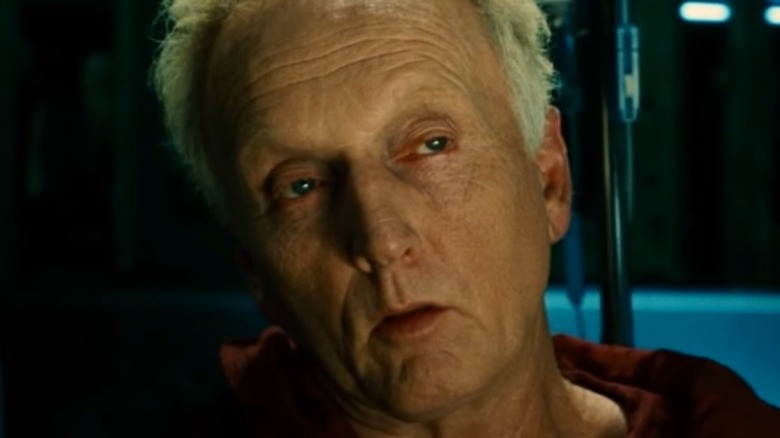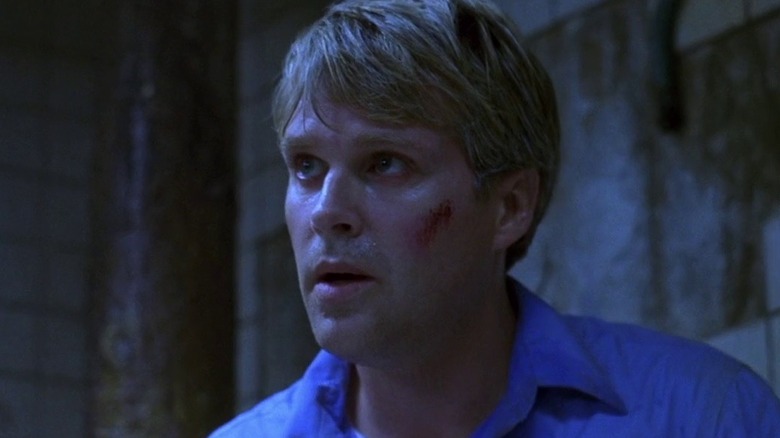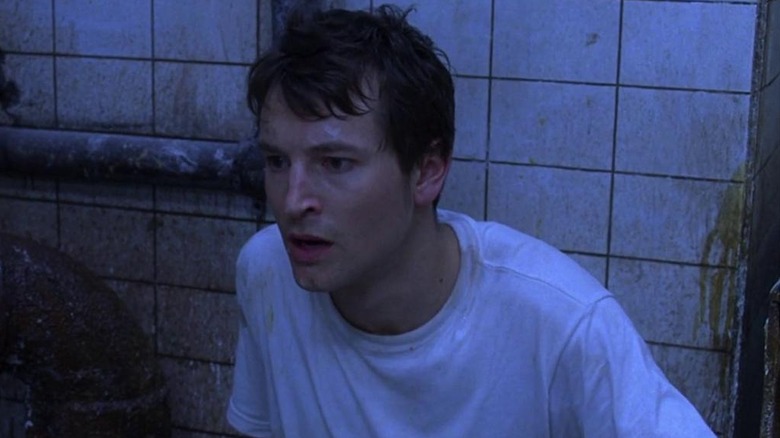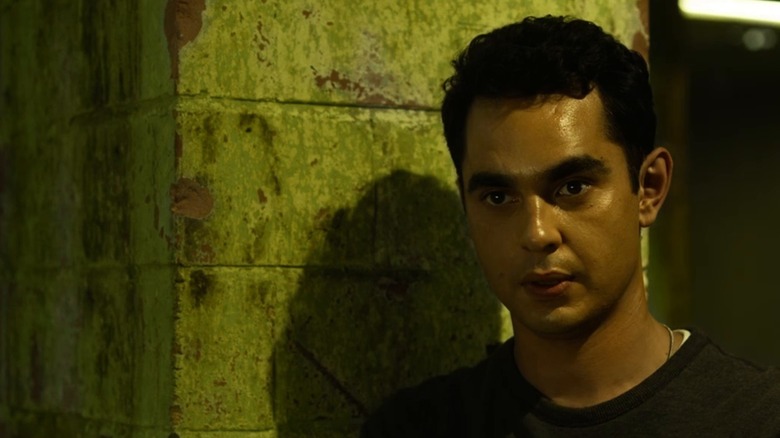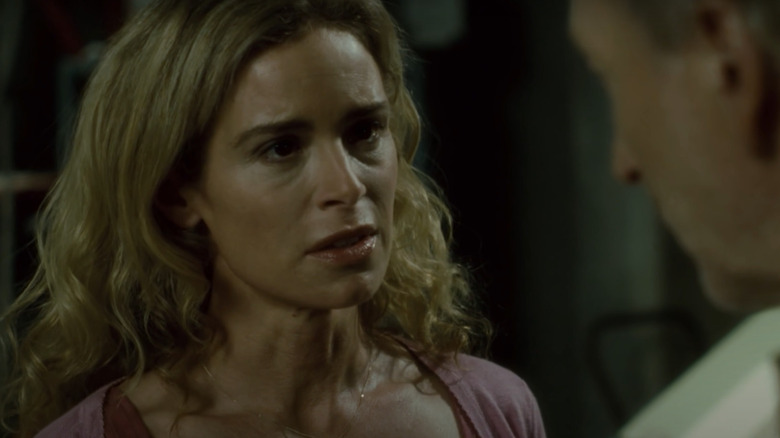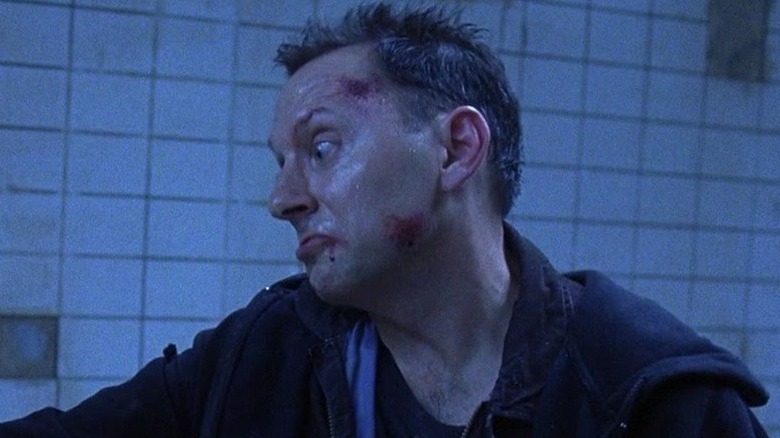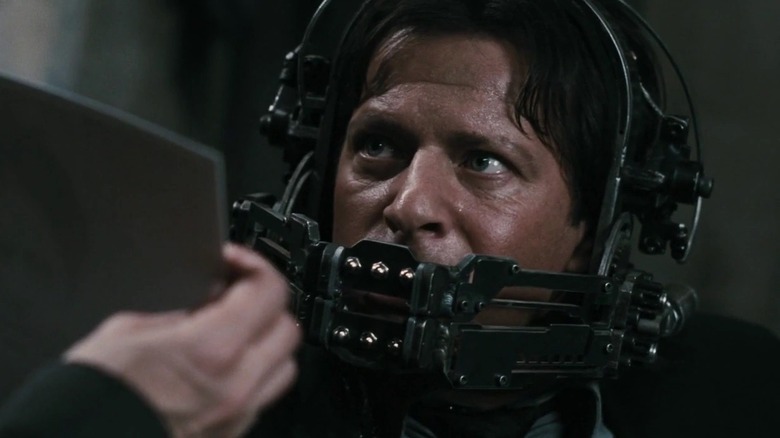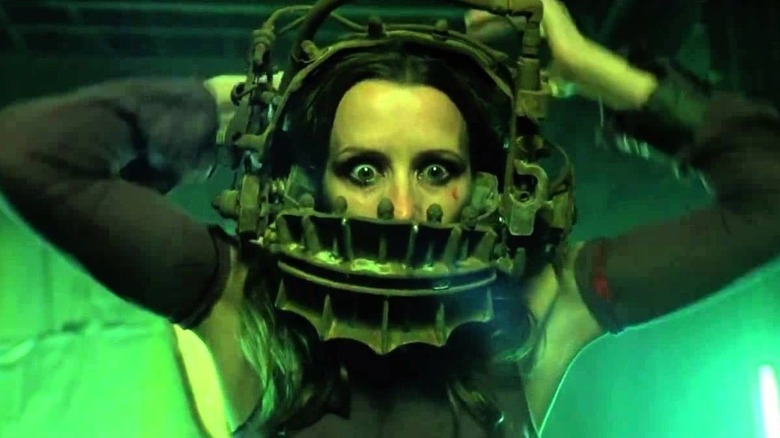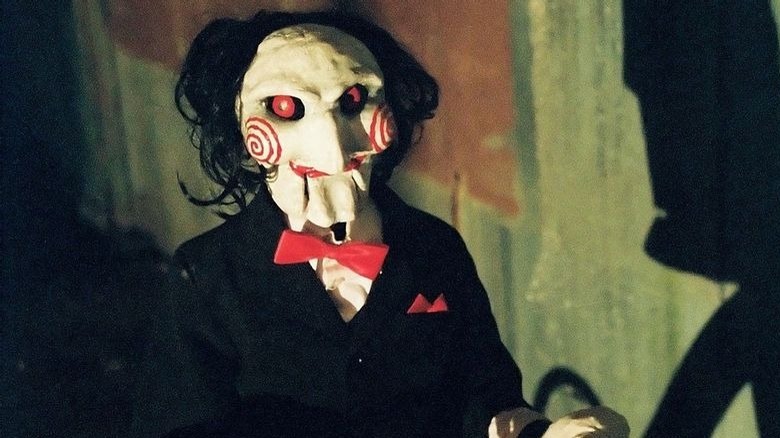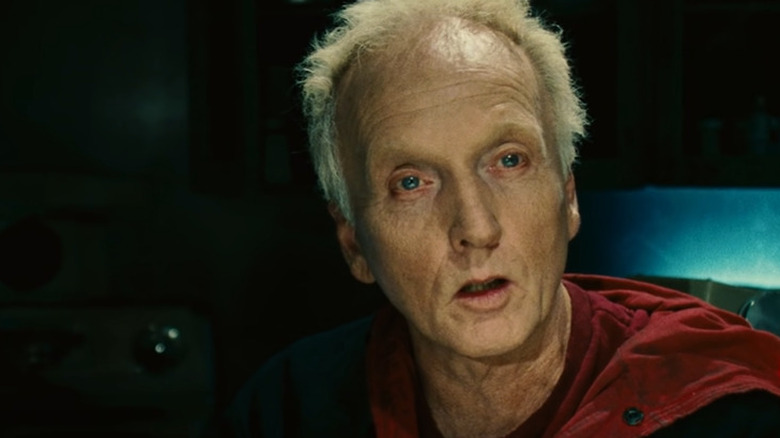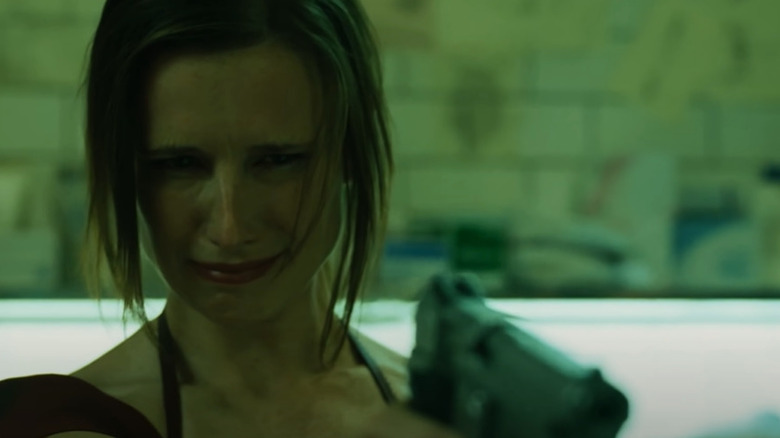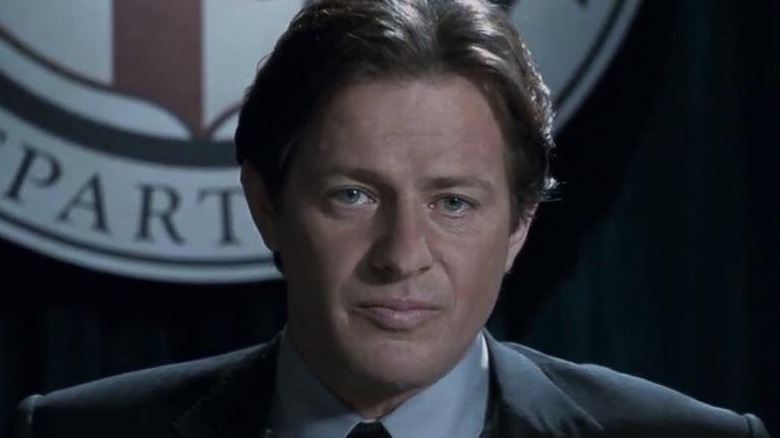Biggest Unanswered Questions From The Saw Franchise
Hello. Let's play a game. This won't involve putting anyone in deadly traps or skulking around town wearing a pig mask, though. That's far too disturbing, and who could even afford to buy all those gadgets and contraptions in this economy? Instead, this game will be about taking a look at the "Saw" franchise and the various spine-chilling events that happen within it — in particular, the parts that have never properly been resolved.
Created by James Wan and Leigh Whannell, "Saw" remains one of the preeminent modern horror series. Jigsaw might not have gone to Hell or space (at least not yet), but it's a franchise that deserves to be mentioned alongside genre hallmarks like "Friday the 13th," "A Nightmare on Elm Street," and "Halloween." With so many films to its name, "Saw" has left some big mysteries unsolved. These aren't necessarily plot holes or arguments about the flaws of the films, but rather just some observations and uncertainties that have kept us up at night. Here are the biggest unanswered questions from the "Saw" franchise.
Why doesn't Lawrence Gordon reveal Jigsaw's identity to the cops?
In the "Saw" franchise, Dr. Lawrence Gordon (Cary Elwes) is one of Jigsaw's first test subjects. He's the former oncologist of John Kramer, and the lesson he needs to learn is to respect life more than he does. In the first film, he famously hacks off his own foot to escape and get to his family. Then he returns later on in the series, revealing that he's become one of Kramer's accomplices.
Interestingly, the police had been keeping close tabs on Dr. Gordon for a while, suspecting that he might have been Jigsaw in the first place. After his ordeal of being traumatically locked in a bathroom and sawing off his own foot, why doesn't he go straight to the police station and tell them everything that happened? Why doesn't he reveal Kramer as the real Jigsaw? As a doctor, he took an oath to protect and save lives, yet he seems to forget about this rather quickly as he embarks on a mission to help Kramer instead. Sure, he might have seen the light and experienced a bit of Stockholm syndrome in the process, but he could have easily put a stop to Jigsaw's reign of terror before it got out of hand.
What does Adam do wrong in the first place?
If Jigsaw's whole modus operandi is to punish those who deserve it, then what did poor Adam Stanheight (Leigh Whannell) do to get himself into such a pickle? According to the first "Saw" film, his biggest crime is following other people around and taking photos of their activities for money. In other words, his job is like every other paparazzi photographer or private investigator on Earth.
Adam never appears to be malicious or intends on causing any kind of serious trouble from his work, as he only tries to make a living in the best way he knows how. Sure, it might not always be the most ethical job, but it's far from evil. Sadly, Adam ends up being nothing more than collateral damage in the story, as Jigsaw seeks out a closer link to Lawrence Gordon and identifies Adam as the perfect subject for his dark experiment. The photographer's doomed fate is simply a case of being in the wrong place at the wrong time. If reporting or documenting what is seen is a crime in the world of "Saw," then a whole lot of people are in serious danger.
Why didn't anyone do a blood test on Schenk's body?
"Spiral" cleverly diverts viewers' attention from the antagonist's true identity by "killing off" William Schenk (Max Minghella) early on in the film. He's supposedly skinned alive, with a piece of his tattooed skin sent to his colleagues at the police force as supposed evidence of his death. Later, we find out that Schenk merely faked his death, and he's revealed to be the real Jigsaw copycat in a monologue that might as well have him twirling a mustache.
This is a truly baffling mistake on the part of the Metropolitan Police Department. While all evidence suggests that the skinless corpse is Schenk's at first glance, not a single soul does a thorough investigation of the body to make sure it's really him. That said, maybe Schenk did plan ahead and choose a victim with a similar profile and blood type as him to throw off any suspicion from the cops. Regardless, that's never discussed in the movie. Instead, everyone just accepts that the corpse must be him.
Why does Jill agree to her ex-husband's request?
When we meet Jill Tuck (Betsy Russell) in the "Saw" franchise, it's revealed that she and John Kramer have been divorced for some time. However, she still knew all about his nightmare factory and his affinity for games that couldn't be played on Nintendo. Jill's sucked back into his world when she receives a final request from him after he passes away. While he does profess his undying love for her on tape, he also asks her to open Pandora's box and take part in his shenanigans.
There are two problems here: One, why does Jill even entertain this request from the grave? If she left her husband because of his extracurricular activities, she must be morally opposed to them. Otherwise, there would be no reason for her to divorce him. And two, if Kramer really loves Jill, why does he make her a part of a game that might not end well for her (it doesn't)? He could have easily asked Dr. Gordon to look after her and leave it at that. Instead, he had to make her a participant in the madness.
How does John Kramer know what Anna did to her baby?
In the "Saw" universe, no one is ever safe. Jigsaw is the all-seeing and all-knowing watcher of humanity, playing judge, jury, and executioner. Throughout each film, it's shown how John Kramer knows all about every person's actions and how he creates lessons tailored to address their behavior. It's also clear that Kramer has a network of followers who watch these people and bring him the intel that he needs. However, there is the chance that Kramer might still operate on a hunch from time to time.
Take Anna (Laura Vandervoort) from "Jigsaw" as a prime example. Kramer reveals that she was his neighbor and that he knows she smothered her baby, then made it appear as if her husband had rolled over in his sleep and accidentally suffocated the child. Yet, in the flashbacks, the only thing that Kramer can really see is that Anna is angry and frustrated by the baby's incessant crying. There's no way that he could see into the room and know for certain that Anna did what he presumes she did. In this instance, it appears he simply guessed that she must have done something without any real proof. How many other people did he do this to?
Why doesn't John Kramer choose Zep as an apprentice?
For the greater part of the first "Saw" film, the audience is led to believe that Zep Hindle (Michael Emerson) is really Jigsaw. However, it's all a clever ruse, as Zep is merely someone who's become an unwilling participant in John Kramer's game. He has his own tape and only does what he needs to in order to survive. Zep had a special history with Kramer, as he served as an orderly at the hospital in which Kramer received treatment for his cancer.
Here's what doesn't make sense about this relationship, though: Zep treated Kramer with a lot more compassion and empathy than Dr. Gordon did and even criticized the other doctors and caregivers for their callous bedside manner. In many ways, Zep was there during the tough times and treated the patients with the dignity they deserved. And yet, instead of recognizing that Zep could be a valuable ally or even a worthy apprentice for him, Kramer puts him in his twisted game. Talk about punishing someone for their good intentions.
Why doesn't Jigsaw test Detective Hoffman earlier?
Judging by the later films and how John Kramer has Jill set up a trap for Detective Mark Hoffman (Costas Mandylor), there's no doubt that Jigsaw's trust in his apprentice was never especially high. It makes sense, since the mastermind of the macabre thought a step ahead of everyone else, planning eventualities in the case of other eventualities. For someone who was so well-versed in preparedness, though, Kramer sure takes his sweet time in teaching Hoffman his lesson.
No matter where you land in the "Saw" timeline, Hoffman is nothing like Kramer. He may set up the torturous traps and lure in the victims, but he doesn't believe in redemption or second chances. He's a sadist and enjoys watching people suffer. In fact, his traps aren't even fair games where someone can survive and learn their lesson; they're death sentences for anyone who gets caught up in them. Since Kramer had eyes everywhere, he must have been aware of his protégé's suspect behavior from early on, yet he inexplicably turns a blind eye for the longest time. Detective Hoffman is the antithesis of what Kramer first set out to do, but Jigsaw lets him carry on with his carnage nonetheless.
How does everyone suddenly become experts in mechanical traps?
"Saw" eventually reveals that John Kramer used his skills as a civil engineer to design the pesky traps that he believed would help people — that's the Jigsaw backstory in a nutshell. These contraptions and devices are undoubtedly brutal and made for nefarious purposes, but they also require a lot of engineering knowhow to operate effectively. It's like the equivalent of trying to build the LEGO Death Star without an instruction manual or knowing where any block goes. Simply put, these games require some expertise that isn't exactly run-of-the-mill.
While it's easy to believe that Kramer knew what he was doing, this doesn't explain how his apprentices turn into engineering geniuses overnight. They might have been able to follow Jigsaw's notes and plans to a T, but the newer contraptions leave us pondering how they put everything together on their own. This isn't like "Mario Kart" where everyone gets the hang of it after a few games — it requires a higher level of understanding and education. Yes, Jigsaw's apprentices might have done some of their own research and picked up a few books to upskill themselves on the basic principles, but if engineering was so easy, then all of us would be building bridges and houses every day.
Where is John Kramer's body?
After the rise of Jigsaw-themed murders in "Jigsaw," the police decide to exhume John Kramer's grave to make sure he's really dead and buried. Inside the grave, they find Edgar Munsen (Josiah Black) instead. However, the later events in the film reveal that Kramer is indeed still deceased and that it was Logan Nelson (Matt Passmore) committing the crimes all along.
However, there's one question that the film never answers: What did Nelson do with Kramer's corpse after removing it from the grave? At that stage in the timeline — 10 years after Kramer's death — it's highly likely that the body was heavily decomposed and possibly unrecognizable, but Nelson must have put it somewhere or disposed of it. Is it in a freezer? In the incinerator? This is a question that needs to be addressed. Otherwise, someone who isn't in the know could presume that Kramer rose from the dead in a future film.
Is John Kramer really ethical?
John Kramer declares that he isn't a killer. He believes that if people have a will to live and are willing to sacrifice, they will. It's why he designs his traps in a way that offers them an opportunity to escape, but at a price. A pound of flesh isn't only a metaphorical term for Kramer.
Darren Lynn Bousman, the director of four "Saw" films, explained to IGN how Kramer sees himself, saying, "He's a person with extreme beliefs and he really thinks he's making a difference. He's a vigilante if anything. He thinks he's making a difference."
While Kramer might see himself as some kind of savior, the truth is otherwise. He plays god with other people's lives because he believes he's coming from a morally superior place. He judges people for their actions instead of realizing that he might not have the full picture, and he comes from a place of presumption as often as not. If he thinks someone is guilty, they automatically are. That doesn't make him ethical; it makes him a killer who's trying to rationalize and justify what they're doing.
How many other apprentices does Jigsaw have?
John Kramer's influence spreads far and wide, even shaping spinoffs like "Spiral," which at its crux is a story about a copycat killer inspired by Jigsaw. In the "Saw" movies, we witness how Kramer manages to lure others into the fold and makes them believe in his special game that's supposed to teach human beings to cherish every single moment they have. From Amanda Young and Lawrence Gordon to Mark Hoffman and Logan Nelson, Kramer has several loyal and devoted apprentices.
What remains unclear, though, is the actual number of disciples he had. Did he only approach people he met in real life and had encounters with, or was he perhaps hosting secret masterclasses on the dark web? Anything is possible, really. At the same time, what about his apprentices' apprentices? Someone like Detective Hoffman certainly looks like the type who would love to have his own legion of devotees and could have set up his own network. As of now, it's unclear just how many dangerous people there are in the "Saw" universe who've been lured into Kramer's dark philosophy.
Is Detective Hoffman still alive?
Detective Mark Hoffman finally gets his comeuppance in "Saw 3D." Lawrence Gordon stays true to his original promise to John Kramer and acts once Jill is brutally murdered. The doctor places Hoffman in the same dingy bathroom from the first film, but he doesn't leave him with a hacksaw or any means of getting out. Instead, he shuts the door and lets him rot. For all intents and purposes, it's game over for Hoffman — or is it?
If "Saw VI" demonstrates anything, it's that Hoffman is smarter than any of us realize, as he escapes the terrifying bear trap in the nick of time. He might have pledged his allegiance to Kramer, but he possesses serious street smarts and understands the importance of always having a backup plan (much like his mentor). He's also studied these traps and knows all the ins and outs — just in case he ever finds himself in one. Considering that the bathroom is so pivotal to the overall "Saw" franchise, Hoffman must be familiar with it and know the various ways to escape from it. Don't bet against seeing this dastardly detective in a future film, revealing how he performed the great escape.
